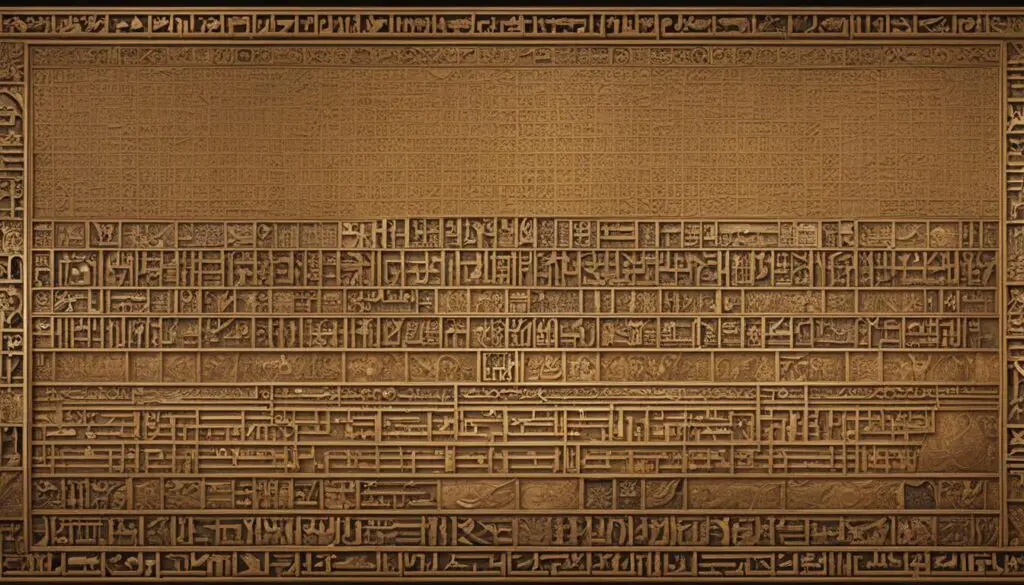
In this section, I will take you on a captivating journey through the history and significance of Ancient Hebrew language and culture. Together, we will explore the roots of Hebrew and its evolution from Biblical Hebrew to Post-Biblical Hebrew. We will uncover the early origins of this Ancient Semitic language and its close ties to religious texts and ancient manuscripts. Furthermore, we will delve into the linguistic transformation Hebrew has undergone over time, revealing its distinctive structure and vocabulary. Throughout, we will discover the enduring impact of Hebrew on Jewish culture and traditions.
Before we embark on this enlightening exploration, let us first understand the key components of Hebrew history. From the Hebrew alphabet, which consists of twenty-two consonants and is steeped in symbolism, to the rich tapestry of Hebrew traditions that have shaped Jewish culture, we will uncover the remarkable heritage of this ancient language. Ancient Israel serves as the backdrop for our journey, offering profound insights into Hebrew literature, customs, and cultural practices.
Key Takeaways:
- Ancient Hebrew language and culture hold significant historical and cultural importance.
- Hebrew evolved from Biblical Hebrew into Post-Biblical Hebrew.
- Hebrew has deep connections to religious texts and ancient manuscripts.
- Linguistic transformations have shaped the structure and vocabulary of Hebrew.
- Hebrew continues to influence Jewish culture and traditions.
Tracing the Roots of Ancient Hebrew: Origins and Evolution
In order to understand the origins and evolution of the Ancient Hebrew language, it is crucial to explore its early roots and its place within the Semitic family of languages. Hebrew, belonging to the Canaanite branch of the Semitic languages, shares many linguistic features with its sister languages such as Aramaic and Arabic. These languages are known for their triconsonantal roots and complex verb conjugations, which provide insight into the linguistic transformation that Hebrew has undergone throughout its history.
Religious texts and ancient manuscripts have played a significant role in preserving the early origins of Hebrew. The Hebrew Bible, also known as the Tanakh, encompasses a vast range of literary genres and provides a glimpse into the language’s development over centuries. The Dead Sea Scrolls, discovered in the mid-20th century, further shed light on Hebrew’s usage during the Second Temple period, offering invaluable insights into its grammar, vocabulary, and linguistic network.
Furthermore, the cultural exchanges between ancient civilizations have contributed to the evolution of Hebrew. The influence of surrounding cultures, such as Egyptian, Babylonian, and Persian, can be seen in Hebrew’s lexicon and phonological changes. These external influences, coupled with internal developments, have shaped the language’s structure and vocabulary over time.
Hebrew’s linguistic journey is a tapestry woven with threads of divine revelation, historical documentation, and cross-cultural interactions.
This intricate linguistic tapestry invites us to explore the intersections of language, history, and culture, offering a deeper understanding of the ancient Hebrew civilization and its enduring legacy today. By tracing the roots of Ancient Hebrew, we unravel the complex web of linguistic transformation, early origins, religious texts, and cultural exchanges that have shaped this remarkable language.

The Journey of Hebrew: Key Highlights
| Period | Highlights |
|---|---|
| Biblical Hebrew | – Language used in the Hebrew Bible – Known for its poetic and prophetic texts |
| Post-Biblical Hebrew | – Development and evolution after the Babylonian exile – Incorporation of Aramaic words and syntax |
| Second Temple Period | – Usage during the period of the Second Temple – Reflected in the Dead Sea Scrolls – Influence of other ancient languages |
| Modern Hebrew Revival | – Efforts by Eliezer Ben-Yehuda to revive Hebrew as a spoken language – Establishment of the Hebrew Language Academy |
The Revival of Hebrew: Breathing Life into a Dormant Language
In this section, I will explore the remarkable revival of Hebrew as a spoken language, highlighting its profound impact on cultural identity and the efforts behind its resurgence.
At the forefront of the Hebrew revival movement was Eliezer Ben-Yehuda, a visionary figure who dedicated his life to bringing Hebrew out of dormancy and into everyday use. Ben-Yehuda believed that a language is not just a means of communication, but a vessel for preserving and strengthening cultural heritage. Through his relentless efforts, he succeeded in establishing Hebrew as the official language of the State of Israel, forever transforming its linguistic landscape.
The Hebrew Language Academy: Standardizing and Adapting Modern Hebrew
A key institution contributing to the revitalization of Hebrew is the Hebrew Language Academy. Founded in 1953, this esteemed organization acts as a linguistic authority, ensuring the standardization and adaptability of modern Hebrew. The Academy’s mission is to preserve the integrity of the Hebrew language while accommodating contemporary needs and developments. By establishing rules and guidelines for grammar, vocabulary, and pronunciation, the Academy has enabled Hebrew to thrive as a dynamic and versatile language in the modern era.
The Linguistic Revolution and Cultural Identity
The revival of Hebrew goes beyond linguistic transformation; it is deeply intertwined with cultural identity. For the Jewish people, the revival of Hebrew has served as a means of reconnecting with their ancient heritage and reclaiming their ancestral language. It has symbolized a reawakening of national pride and unity, fostering a sense of belonging and solidarity among Hebrew speakers worldwide.
The language revival efforts surrounding Hebrew are part of a broader movement to preserve endangered languages. By reviving and revitalizing languages on the brink of extinction, we not only preserve linguistic diversity but also honor the rights and cultural autonomy of indigenous communities. Supporting language revival is not merely a practical endeavor but an ethical and aesthetic imperative, ensuring that the tapestry of human languages remains vibrant and alive.
FAQ
What is the history of the Ancient Hebrew language?
The Ancient Hebrew language has a rich and fascinating history, dating back to ancient times. It evolved from Biblical Hebrew to Post-Biblical Hebrew and played a significant role in religious texts and ancient manuscripts.
How is Ancient Hebrew connected to Jewish culture and traditions?
Ancient Hebrew is deeply intertwined with Jewish culture and traditions. It served as the language of religious texts, such as the Hebrew Bible, and played a crucial role in preserving Jewish heritage and customs.
How did Hebrew evolve over time?
Hebrew has undergone linguistic transformations throughout its history. From its early origins as a Semitic language, it has developed into different forms, adapting to societal and cultural changes while retaining its unique structure and vocabulary.
Who were the key figures in the revival of the Hebrew language?
Eliezer Ben-Yehuda was a prominent advocate for the revival of Hebrew as a spoken language. His unwavering commitment to preserving cultural identity through language paved the way for the establishment of the Hebrew Language Academy, which played a crucial role in standardizing and revitalizing Hebrew.
Why is language revival significant?
Language revival efforts, like the revival of Hebrew, are important for ethical, practical, and aesthetic reasons. They help preserve cultural heritage, foster a sense of identity, and promote linguistic diversity, ensuring the continuity and vitality of endangered languages.
Source Links
- https://www.chicagojewishnews.com/unraveling-the-growth-of-the-hebrew-language-a-journey-through-edward-horowitzs-book/
- https://www.chicagojewishnews.com/the-vanishing-script-unraveling-the-fate-of-the-hebrew-language/
- https://www.pangea.global/blog/a-brief-history-of-revived-languages-from-hebrew-to-wampanoag/








